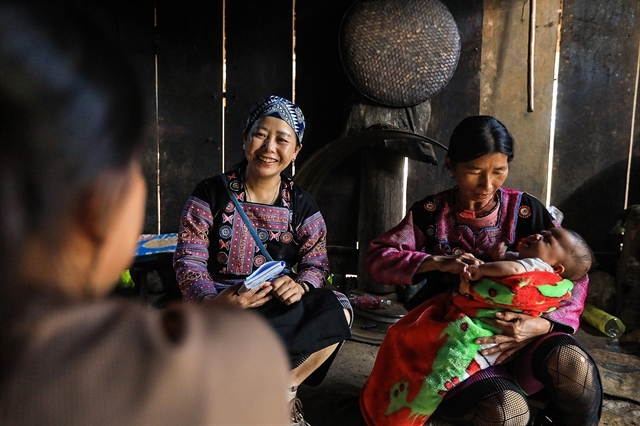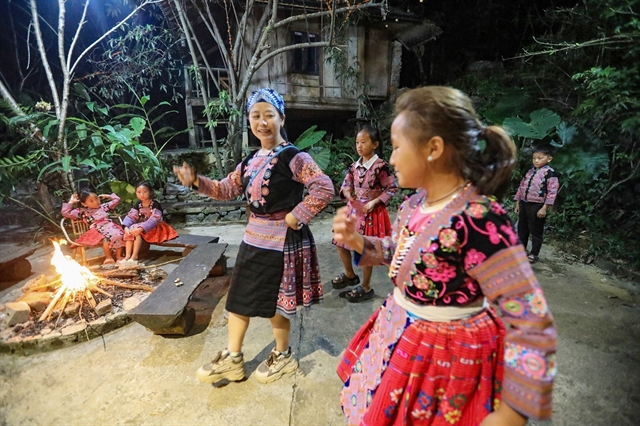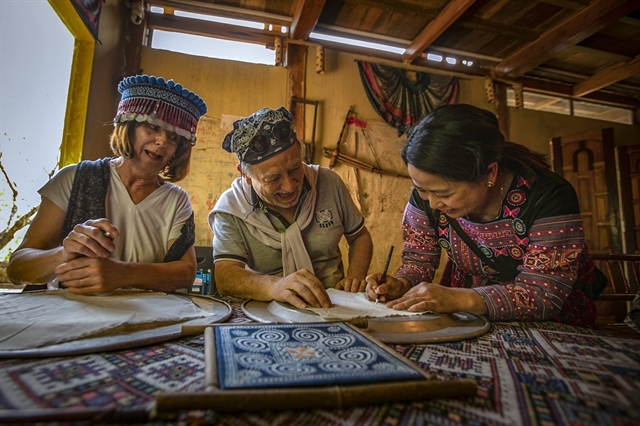 Society
Society


|
| Sùng Y Múa encourages Mông women in Hang Kia Commune in Hòa Bình Province to visit the health centre for medical check-ups, childbirth assistance and maternal and child health care. VNA/VNS Photos Trọng Đạt |
HÒA BÌNH — Sùng Y Múa, a health officer at the Hang Kia Commune Medical Centre in Mai Châu District in the mountainous northern province of Hòa Bình, is a pioneer in changing the mindsets of Mông youths in the commune.
With her youthful energy and professional knowledge, Múa is proactive and creative in finding ways to improve her homeland while preserving Mông culture, contributing to a better community.
In August 2005, after graduating from a medical training programme, Múa returned to her village, taking up a health officer role in Hang Kia Commune.
Over the past 20 years, she has worked tirelessly with local authorities in Hang Kia and Pà Cò communes to educate the Mông community on disease prevention and to encourage Mông women to visit the health centre for medical check-ups, childbirth assistance and maternal and child health care.
Múa has also worked with organisations and respected village elders to form teams that go to every household in the commune, sharing information about Party policies and State laws.
.jpg)
|
| Múa goes to every household in the commune, sharing information about Party policies and State laws. |
This approach has gradually helped reduce issues such as drug abuse, child marriage and superstitions among the Mông community in Hang Kia Commune.
Múa has a deep commitment to helping children in difficult circumstances, including in two particular families, Khà A Váu and Vàng Y Dua. Recognising the challenges faced by these families and others like them, she decided to support their two children, Khà Y Bào and Khà A Lềnh.
For the past six years, Múa has regularly visited the children, providing rice, school supplies and clothing to ensure they stay healthy and can attend school.
Múa has also established three dance teams, personally teaching traditional Mông dances and songs to the younger generation in hopes of preserving their cultural heritage.

|
| Múa teaching traditional Mông dances and songs to Mông girls in hopes of preserving cultural heritage. |
Vàng A Páo, Vice Chairman of the Hang Kia Commune People’s Committee, shared that over the years, alongside other staff at the Hang Kia Health Centre, Múa has shown great dedication in caring for the community’s health.
She has been instrumental in educating the people of Hang Kia, helping them gradually abandon outdated practices like child marriage and drug use, as well as misconceptions about health and superstitions.
Now, most residents, especially Mông girls and women, actively come to the health centre for check-ups, medicine and childbirth services, he said.
Vision for a prosperous and modern Mông Village
Múa is determined to break the cycle of poverty for Mông women by reducing high rates of school dropouts, early marriage, and other customs now seen as 'backward'.
In the mid-1990s, Hang Kia began to see change, with the arrival of both domestic and international tourists coming to explore the lives and traditions of the Mông community.
As a native of Hang Kia, Múa understands the importance of preserving the cultural beauty that is fading. This includes cultural activities like building Mông traditional houses, Mông cooking, playing folk games, brocade weaving and wax painting.

|
| Múa instructs foreign tourists to make brocade weaving at her homestay. |
This realisation gave her a bold idea to help lift her community out of poverty by building on these cultural strengths.
Múa became a trailblazer for Mông women by starting a homestay business on the unique terrain of Hang Kia - Pà Cò in Mai Châu District. Her successful community tourism model, Homestay Y Múa in Hang Kia Commune, has encouraged others to join this effort.
Apart from the community tourism model, Múa is developing a cultural space to preserve both the traditional and modern cultural values of the Mông people. This space will offer visitors a complete experience of the region’s rich heritage.
Currently, Hang Kia has six homestays serving the needs of tourists. Each year, visitor numbers increase, helping to sustain and grow traditional crafts and tourism products unique to the Mông community.
Vàng A Váu, Party Secretary of Hang Kia Commune, said that the Y Múa Homestay has promoted the beauty of the Mông village of Hang Kia to both domestic and international tourists, fostering the growth of local community tourism.
Hoàng Đức Minh, Vice Chairman of Mai Châu District’s People’s Committee said that Hang Kia has now become a recognised destination on the tourism map, known for its good weather and the friendliness and hospitality of its people.
Múa’s efforts have strongly inspired the Mông community and its younger generations to find creative ways to prosper in their homeland while preserving Mông culture, he said. — VNS




